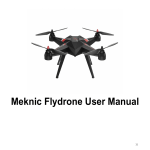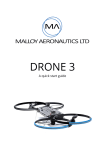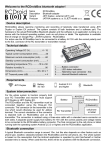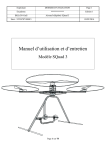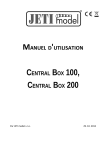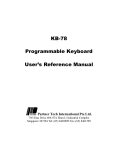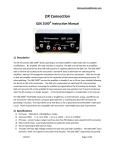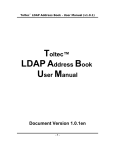Download User Manual HELI ALT Hold Unit
Transcript
HELI ALT Hold Unit User Manual HELI ALT Hold Unit Page 1 of 7 Tube Technical data: Operation voltage: Current consumption: Operation temperature: Operation altitude above sea level: Weight Measurements Barometric sensor H1 mode In case of CCPM mixing you must mix the servo movements on board of the heli and plug the pitch lead in to the mixing device like the Helicommand or similar. Connection schema HELI ALT Hold ver. 1.1x Intelligent control unit Pitch RX Button Gen. Pitch Unit On/Off Led JeTi Box Batt. 5..15V Pitch RC Receiver Unit On/Off LED - + - + JETI BOX Safety Accu 5..15V Batt. 2 Pitch RX Button Gen. Pitch Unit On/Off LED JeTi Box Batt.. Batt. 1 = 4.8 - 6 V Batt. 2 = 5 - 15 V 50 mA -10...70 Celsius 0 - 2500m 30g 50x30x13 mm 4.8V Receiver Accu Batt. 1 servo signal from the receiver, TX must be set to H1 Heli Mode external calibration button input servo signal generator output pitch servo output receiver servo signal input indication LED output HELI ALT Hold unit setting input external battery socket The HELI ALT Hold was designed to help the pilot maintain desired altitude when filming or taking pictures from RC helicopter. It can maintain present altitude, or programmed altitude. As its side function it can generate constant servo signal to free a channel on the transmitter. Example: gyro or governor sensitivity setting. It works only if there is another devise mixing the CCPM servos signals on the board of your machine. (For example Helicommand or similar devices. The transmitter is set to H1 mode where each function operates only one servo. HELI ALT Hold outputs only one servo signal for the collective pitch function. HELI ALT Hold may be powered from the receiver battery as well as from an external pack plugged directly in to the unit. If you decide not to use the external battery be aware of this: The RC battery must supply voltage from 4.8 up to 6.5V. If it drops below 4.8V the internal barometric pressure sensor voltage reference will start working with a certain offset. In reality the HOLD PRESENT LEVEL function will be not affected by this, only the PREPROGRAMMED ALTITUDE will differ from the real maintained. Example: The voltage has dropped below the stated level. The programed altitude is set to 15 meters. The heli will maintain the height at 10 meters due to the low internal voltage reference. All other functions would stay unaffected. We suggest to use both types of powering the unit. It will increase the safety of using the device. The external battery would power only the HELI ALT Hold circuits without effecting the rest of the electronics on the helicopter. The unit will always drew current from the battery with higher voltage. Page 2 of 7 Transmitter setting 1. As you are already using some kind of stabilisation device the heli is set to H1 mode (one channel for one collective function) No mixing in the transmitter but on your machine using other devices. H1 2. Select a three momentary switch used for ALT Hold enable channel. Select the values for the three positions like this: Low position Middle position High position 1.3 1.5 1.7 ms Volt TX-bar Volt TX-bar Volt TX-bar 1.3 1.5 1.7 ms 1.3 1.5 1.7 ms Low position - servo signal width must be set below 1.3 ms (typically 1... 1.29 ms). This position switches on the “MAINTAIN PRESENT ALTITUDE”. The LED will light. Pilot does not control the collective pitch function Middle position - servo signal width must be set to 1.3 ms .... 1.7 ms (typically 1.31 ... 1.69 ms). This position disables the ALT Hold. The LED is not active. Pilot controls the collective pitch. High position - servo signal width must be set higher than 1.7 ms (typically 1.71 ... 2.1 ms). This position switches on the “MAINTAIN PREPROGRAMMED ALTITUDE”. The LED will light. Pilot does not control the collective pitch function. Servo signal width leaving the receiver should be kept in these limits: Min. signal from TX Volt Volt Max. signal from TX 0.9 1.5 2.1 ms 0.9 1.5 2.1 ms Page 3 of 7 Programming the althold by JETIBOX 1 Step 1 - connect the JeTi Box 2 Step 2 - connect power supply HELI ALT Hold ver. 1.1x Intelligent control unit Pitch RX Button Gen. Pitch Unit On/Off Led JeTi Box Batt. 5..15V Pitch RC Receiver Unit On/Off LED 2 1 JETI BOX - + First connect the JeTiBox 4.8V Receiver Accu Batt. 1 JeTi Box will show initial menu and you can start the setting - see JeTi diagram Alt Hold-HELI ver.1.xx Last held alt. 0000 m Select settings HELI Select heli weight Hover weight 1 SET 1.5 ms Hover weight 2 SET AltHLD Heli weight 1 Altitude 1.4 ms Hover weight 3 SET 121 m Pitch servo min. 1.3 ms -0.21ms Pitch servo max. +0.18ms Disconect JeTiB Then calibrate Servo delay 005 JETI BOX Output Generator Disconnect JeTiBox 1.18ms Data stored Page 4 of 7 MENUS Alt Hold-HELI menu Alt Hold-HELI ver.1.xx This would give the gadget name as well as the software version. Last held altitude - menu Last held alt. 0000 m The last HOLD PRESENT ALTITUDE command will memorize its actual altitude to the internal eeprom. It will stay there until the new record. Select settings - menu HELI - Here you calibrate the hover point in presence of three pay loads. Select settings HELI AltHLD AltHLD - Here you choose the payload and enter the height if desired Please go to page 5 Hover weight - menu Number of the payload set Hover weight 1 SET 1.5 ms Purpose: The HELI ALT Hold needs to know where the collective hover point is carrying different payloads. We have included three heli payload combinations to satisfy general needs. If the payload is switched during the job, you just enter a different heli weight number of the set up already calibrated. Hower weights (1 to 3). We suggest using the three possibilities like this: Last stored value Hover weight 1 - Without payload for testing reasons Hover weight 2 - Intended to use with the camera and cradle added weight Hover weight 3 - Intended for the video camera use. Disconnect JeTi B Then calibrate Hover point setting NO How to do the calibration of hover points 1. Select hover weight number - 1 to 3 2. Push the left arrow for SET - after you can see what the arrow points at. 3. Disconnect the JeTi Box (calibrate - meaning in flight) 4. Switch the three position switch to the middle position. LED does not light. 5. Hover the heli at a height where it is not influenced by the ground effect. 6. If happy with the way it hovers, flip the switch from middle to any position. Return the switch to the middle position. This is important. If you do not return the switch, the ALT Hold will monitor the collective pitch signal until you land and switch off the battery. This will result in to saving the collective pitch position at the time of switching off the battery. You can do this procedure how many times you want. The hover point value is stored when the switch is returned to the middle position. 7. Land and switch the power off. Hover point calibration for this particular hover weight has ended. Repeat this procedure for each heli weight number with the appropriate payloads added to the helicopter. If you are already using the spare battery do not forget to switch it of as well as the RC battery. We suggest going through the calibration without the auxiliary battery to make the switch off and on process easier. The following steps are just for checking that the unit really saved different values for each hover point. They are not important for the calibration. 8. Connect the JeTi Box again and switch the power on 9. Find the menu Hover weight 1 (or the hover weight you are working on) 10. In adequate menu check the “Last stored value”. There you can see the stored value of the new hover point. Page 5 of 7 MENUS ALT Hold menu: Select settings HELI AltHLD Here you set the ALT Hold functions: - Programmed altitude for each heli weight - Positive and negative Pitch offset from the hover point. The ALT Hold uses this to move the collective signal in order to maintain the level. - servo signal generator (to free a channel if needed) Please go to page 4 follow the diagram for the setting Heli weight - menu Select heli weight Heli weight 1 Select the heli weight for which the following settings will be made Change value Altitude - menu Altitude: (Note: Altitude value is valid for all 3 heli weights) Altitude 121 m Change value High position TX-bar This comes handful if you want to take pictures from a desired altitude level. You set it here and the heli will go there after the function is switched on. The actual precision is given by the sensor tube entrance position as well as the take off altitude. Here I want to say that if the height is set for example to 20 meters, it does not mean the heli would go to 20 meters above the take off point and hold there. It means It will go always to the same altitude but it does not have to be exactly 20 meters because of the thinks mentioned above. The low voltage influence was already spoken about. If you really intend to work with this feature a lot and the entered altitude does not refer to the really maintained, you can make a calibration chart for your set up where entered altitude would mean different altitude really maintained. “MAINTAIN PREPROGRAMMED ALTITUDE” is switched on by the three position switch flipped to the high position (servo signal bigger than 1.7 ms) Pitch servo menu: Pitch servo - menu Determines how brutal or smooth the ALT Hold keeps the altitude. You must give it a try. Start with the 50% of the setting. If it is too lazy, increase. Pitch servo min. -0.21ms Change value Pitch servo max. +0.27ms Change value This menu determines the maximum collective down movement from the hover point. While setting it watch the swash plate. It must go down. Realize: The more the ALT Hold activation altitude differs from the PREPROGRAMMED ALTITUDE, the bigger offset from the hover point is going to be used. It is the ALT Hold maintain altitude logic. Think of it when flying and test it to know what to expect from your helicopter. This menu determines the maximum collective up movement from the hover point. While setting it, watch the swash plate. It must go up. Do not get confused by the + and - indication on the display. It indicates the signal level only and has nothing to do with the collective movement. This value could be negative or positive it depends on the servo reverse status. The middle position of the collective pitch signal is the hover point of your helicopter for the given heli weight. Example: If the hover value is 1.50ms after settings and the Pitch servo min.= +0.27 ms, than total maximum value for collective down is: 1.50 + 0.27 = 1.77 ms. This will be used as a max collective down move. In other words Alt Hold would not drive the collective pitch behind this setting. Page 6 of 7 MENUS The speed of the collective pitch reaction to go back to the desired altitude if the height was changed due to the outside forces (wind or turbulence and so on) 1 - fast reaction 9 - slow reaction Servo delay 005 Change value Servo signal generator output - very useful to free a channel on the receiver. Typical use for a governor setting or gyro sensitivity setting. Pitch RX Button Output Generator Gen. 1.18ms Pitch Unit On/Off Led JeTi Box Batt. 5..15V Change value Data stored Servo signal generator runs constantly. It is not possible to switch it off. All set parameters are stored in the internal memory BEFORE THE FIRST FLIGHT Supposing you have done the hover point calibration procedure. (Do it without hovering at first to learn the procedure) Check all functions on your heli and on your transmitter H1 Calibrate the pressure sensor Pitch RX Button 1 Gen. Pitch Unit On/Off Led JeTi Box Batt. 5..15V LED - + 2 Batt 3 We suggest you calibrate before each flight. That way the sensor knows the altitude at the ground level. This affects the preprogrammed altitude - if you did not calibrate and then send the heli to the programmed altitude, it would go to that height with respect to the last calibration. Realize that atmospheric pressure changes. Realize that various take off locations can differ by their altitude. All this affects the sensor. Note: if you want to maintain present level the calibration does not matter. How to do it? 1. Disconnect the HELI ALT Hold power supply 2. Keep the calibration button pressed 3. Switch on the power supply for the HELI ALT Hold unit 4. LED must start blinking 5. Release the button, LED is still blinking. 6. Calibration time is 7 - 10 seconds 7. Completed after the LED has stopped blinking 8. Memorized until the new calibration Page 7 of 7 Preflight test of the HELI ALT Hold unit functions - on the ground Middle position TX-bar 2.1 ms LED = OFF Collective pitch controlled from TX, it moves according to the pitch stick position. 1.5 ms 0.9 ms Low position TX-bar 2.1 ms LED = ON Collective pitch controlled by the ALT Hold. PILOT NOT IN COMMAND of the collective pitch. ALT Hold moves the swash plate to the hover point, as it maintains present level. In the meantime the present altitude is saved in the menu LAST HELD ALTITUDE. Is it there? It should display 0000 or 0001 as the heli did not climb anywhere still being on the ground. LED = ON Collective pitch controlled by the ALT Hold. PILOT NOT IN COMMAND of the collective pitch. ALT Hold moves the swash plate some distance above the hover point as it wants to climb to the programmed altitude. The more the programmed altitude differs from the ground altitude, the more the collective pitch moves. 1.5 ms 0.9 ms High position TX-bar 2.1 ms 1.5 ms 0.9 ms Important notes: (Of course you must have entered the programmed altitude beforehand) When the ALT Hold is on, you are not in control of the collective pitch. Be always prepared to switch the ALT Hold off. When switching the ALT Hold modes in flight, make sure the TX collective pitch stick is close to the hover position. If it is not, expect sudden altitude changes. Example: You send the heli to the programmed 50m altitude. While enjoying the automatic hover, you have shifted the collective stick down without knowing. Than you switch the ALT Hold off. The heli will jump in to a fast descent because your collective stick is in a negative pitch position. YO-YO EFFECT: This does not refer to the Hold Present Level function, but rather Go To The Preprogrammed Altitude. It happens when the heli is higher than the programmed level. The more the activation height differs from the programmed altitude, the bigger the yo-yo effect is. Example: Programmed level 70m. Your heli is at 150m. There you switch on the Go To The programmed Altitude. The heli will start descend quite fast. The height difference is big, therefore the collective pitch down offset from the hover point is big as well. The heli crosses the programmed 70m level, stops somewhere about 50m and climbs to 70m to hold there. Do not activate the Go To The Preprogrammed Altitude if the heli is much higher than the programmed level. Also take in to consideration the weight of the heli and its power. If the programmed level is set too low, the heli could hit the ground due to the yo-yo effect. Avoid moisture, do not blow in to the sensor tube touching it with the lips but only blow air distanced in to the tube to check the sensor is working. Place the sensor tube entrance to a convenient place (where there are no sudden pressure changes). It could be right below the rotor blade holders, inside the canopy, below the canopy, above the rear rotor. It needs to be tried for each heli. The tube entrance should be enclosed by some kind of foam that lets air go through easily. Questions regarding the Heli Alt Hold can be sent via email. [email protected] See the Alt Hold video use at www.leteckafotografie.com - section Heli Alt Hold Product manufactured by www.modelcam.cz Heli Alt Hold is warranted to be free from defects in materials and workmanship for a period of one year from the date of purchase. This limited warranty covers normal use and does not cover abuse or use not in accordance with this manual. Under no circumstance will the seller be responsible for any incidental or consequential damages, which may occur during the use of this product, or as a result of the product's failure to perform.








